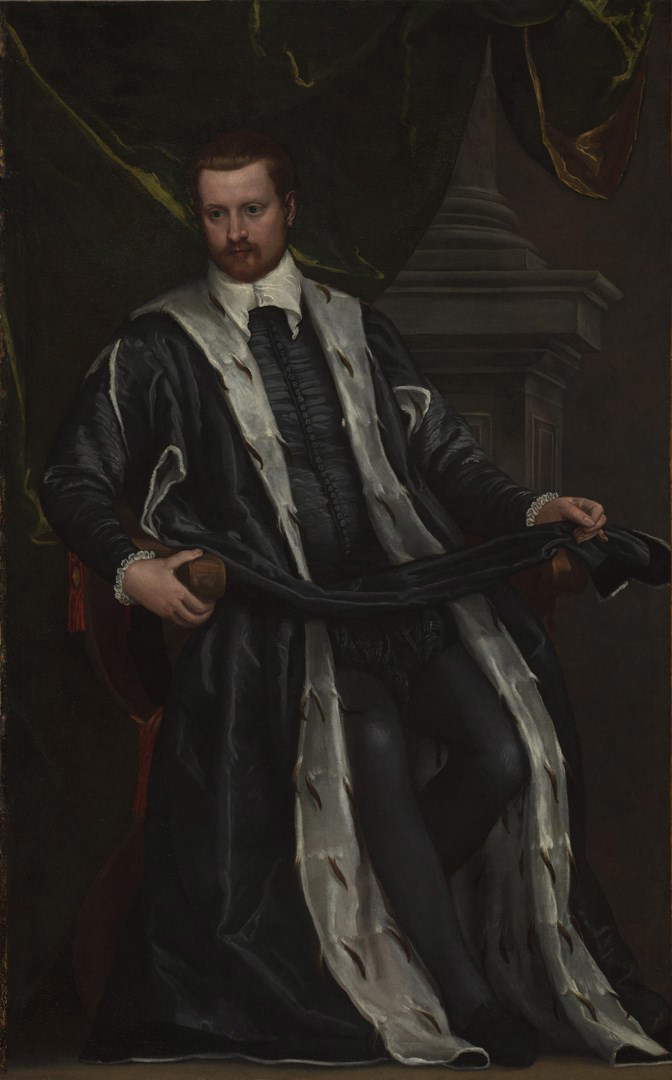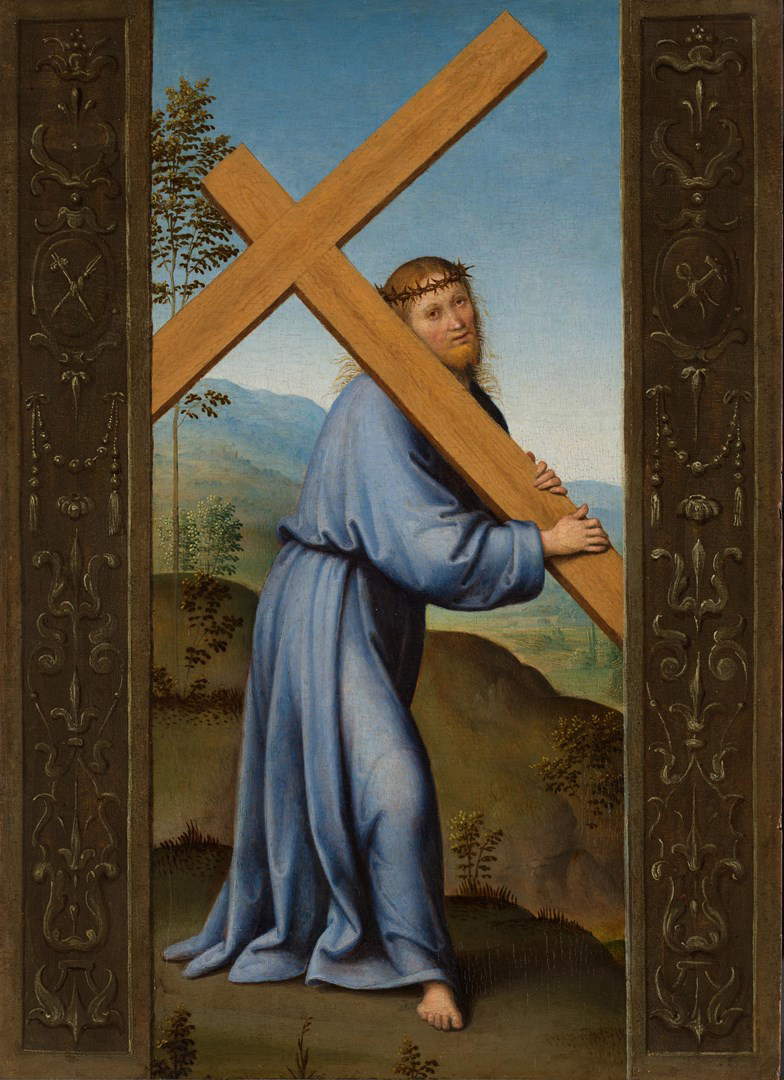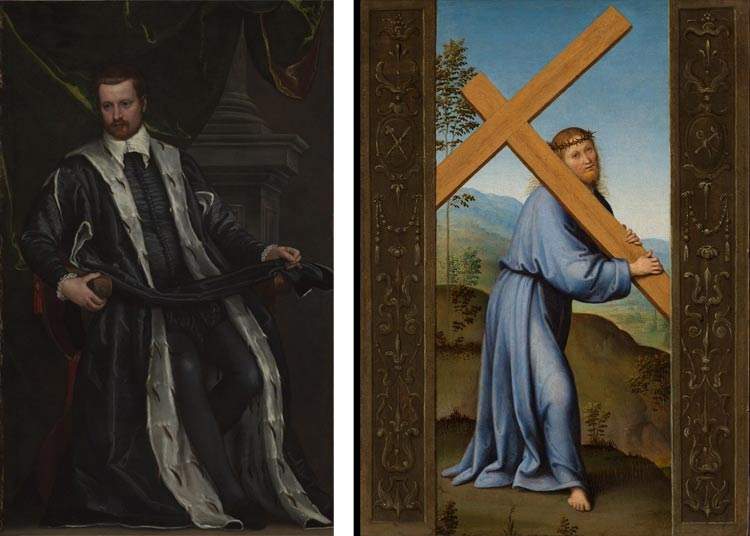Two new paintings enrich the collections of the National Gallery in London, one by Veronese (Paolo Caliari; Verona, 1528 - Venice, 1588), and one by Giovanni di Pietro known as Lo Spagna (active 1504 - Spoleto, 1528): they are a Portrait of a Gentleman of the Soranzo Family and a Christ Carrying the Cross, respectively, which arrived at the museum thanks to the institution of Acceptance in lieu, or the possibility for a citizen to settle a tax debt in goods rather than money. The two works are already in the museum itinerary: the portrait by Veronese in Room 12 and the Christ Carrying the Cross by Spagna in Room 61.
The Portrait of a Gentleman of the Soranzo Family is an important work for the British museum because it was the only full-length portrait by Paolo Veronese remaining in private hands in the United Kingdom and one of the very few existing in the world. Therefore, this acquisition is considered by the National Gallery to be a unique opportunity to enrich its collection. Although Veronese was one of the leading Venetian painters of the Renaissance, he produced very few independent portraits. Until this most recent acquisition, the core of Veronese’s works at the National Gallery included 10 paintings, none of them portraits and none dating from the last years of his life. This large full-length portrait depicts a gentleman sitting on a chair in front of a column. Behind him a green drape is observed. The subject looks intently to his right, wearing a luxurious black satin gown edged with ermine. Historical sources identify the figure as a member of the Soranzo family, an important Venetian noble clan for whom Veronese worked during much of his career.
The work was executed a few years before the artist’s death. The restrained palette, the marked play of light and shadow, and the loose treatment of the paint suggest a date around 1585. Unlike most portraits of Veronese’s later years, which are largely executed by his workshop assistants, the Gentleman of the Soranzo family is believed to be almost entirely produced by the master’s hand. The portrait is a strong complement to other major 16th-century portraits in the National Gallery’s collection and connects to the broader history of full-length portraiture in Europe. Portraits by Titian, Bronzino, and Hans Holbein the Younger stand side by side in Room 12, and consequently this work by Veronese is an important enrichment. Portrait of a Gentleman of the Soranzo Family was accepted in lieu of a fee of under a hybrid arrangement and assigned to the National Gallery. The painting was accepted in lieu of a tax liability of 3,431,682 pounds, and the National Gallery, to which it was permanently assigned under the terms of the offer, put up the difference, thanks to a donation of 5,721,318 pounds guaranteed by the American Friends of the National Gallery.Acceptance in Lieu was negotiated by Christie’s.

In contrast, Spain’s Christ Carrying the Cross will strengthen the National Gallery’s rich holdings of central Italian paintings made around 1500 and will permanently bring together two paintings made for the same complex. The work was made together with Christ at Gethsemane, which has been part of the National Gallery’s collection since 1900. It seems likely that these panels were the side compartments of a small portable altar. The central compartment has been lost, but it probably depicted a crucifixion scene. Both the Christ Carrying the Cross and the Christ at Gethsemane are described in 19th-century sources as coming from the Medici-Riccardi Palace in Florence.
In the Christ Carrying the Cross, Spain removed the usual narrative elements of the scene. Christ appears alone on his way to death, without the procession that traditionally accompanies him. Stooped under the weight of the large wooden cross, Christ turns his gaze toward the viewer as he advances along the road to Calvary. Behind him a raised area of land opens onto a vast Umbrian landscape. Spagna was one of Pietro Perugino’s most talented collaborators at a time when Perugino was the most admired and successful artist in central Italy. The Christ Carrying the Cross and is a rare example of Spain’s small-scale work in the years at the turn of the 16th century, which constitute the early part of his career as an independent master. He was still heavily indebted to Perugino, but his lively approach to figure and narrative reveals very directly the influence of Raphael, alongside whom he had to work. Obviously Christ Carrying the Cross will be exhibited alongside Christ at Gethsemane. The work was accepted in lieu of the estate tax due from the Estate of The Rt Hon the Countess of Sutherland in the amount of £52,500.Acceptance in Lieu was negotiated by Sotheby’s.

“Acceptance in Lieu,” says Gabriele Finaldi, director of the National Gallery, “has brought two important 16th-century Italian paintings into the National Gallery’s collection We are grateful to His Majesty’s Government for making them available to the public in perpetuity.”
Edward Harley, Chairman of the Acceptance in Lieu Panel, said, “I am delighted that the Acceptance in Lieu scheme has enabled the acquisition of these two fine Italian paintings. It is fitting that Spain’s Christ Carrying the Cross should be assigned to the National Gallery, which holds its pendant, Christ at Gethsemane. The Portrait of a Gentleman of the Soranzo Family is the only portrait by Veronese in the United Kingdom and one of the few full-length portraits of the artist in existence.”
Arts Minister Lord Parkinson said, “This scheme exists so that important works of art and heritage objects can be owned by all of us and displayed for the enjoyment of all. It is wonderful that these two outstanding works are now on display at the National Gallery, where they can be seen and appreciated by visitors from all over the country -- and all over the world -- as the Gallery approaches its bicentenary.”
 |
| National Gallery strike, acquired two important paintings by Veronese and Spagna |
Warning: the translation into English of the original Italian article was created using automatic tools. We undertake to review all articles, but we do not guarantee the total absence of inaccuracies in the translation due to the program. You can find the original by clicking on the ITA button. If you find any mistake,please contact us.